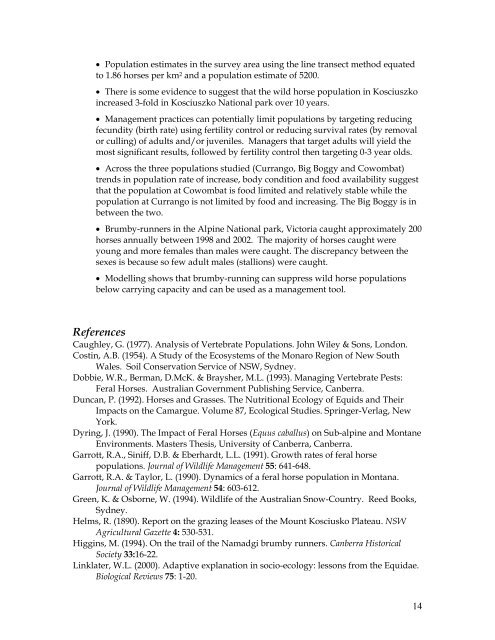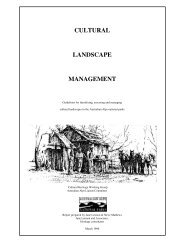The Population Ecology of Wild Horses in the Australian Alps
The Population Ecology of Wild Horses in the Australian Alps
The Population Ecology of Wild Horses in the Australian Alps
Create successful ePaper yourself
Turn your PDF publications into a flip-book with our unique Google optimized e-Paper software.
• <strong>Population</strong> estimates <strong>in</strong> <strong>the</strong> survey area us<strong>in</strong>g <strong>the</strong> l<strong>in</strong>e transect method equated<br />
to 1.86 horses per km 2 and a population estimate <strong>of</strong> 5200.<br />
• <strong>The</strong>re is some evidence to suggest that <strong>the</strong> wild horse population <strong>in</strong> Kosciuszko<br />
<strong>in</strong>creased 3-fold <strong>in</strong> Kosciuszko National park over 10 years.<br />
• Management practices can potentially limit populations by target<strong>in</strong>g reduc<strong>in</strong>g<br />
fecundity (birth rate) us<strong>in</strong>g fertility control or reduc<strong>in</strong>g survival rates (by removal<br />
or cull<strong>in</strong>g) <strong>of</strong> adults and/or juveniles. Managers that target adults will yield <strong>the</strong><br />
most significant results, followed by fertility control <strong>the</strong>n target<strong>in</strong>g 0-3 year olds.<br />
• Across <strong>the</strong> three populations studied (Currango, Big Boggy and Cowombat)<br />
trends <strong>in</strong> population rate <strong>of</strong> <strong>in</strong>crease, body condition and food availability suggest<br />
that <strong>the</strong> population at Cowombat is food limited and relatively stable while <strong>the</strong><br />
population at Currango is not limited by food and <strong>in</strong>creas<strong>in</strong>g. <strong>The</strong> Big Boggy is <strong>in</strong><br />
between <strong>the</strong> two.<br />
• Brumby-runners <strong>in</strong> <strong>the</strong> Alp<strong>in</strong>e National park, Victoria caught approximately 200<br />
horses annually between 1998 and 2002. <strong>The</strong> majority <strong>of</strong> horses caught were<br />
young and more females than males were caught. <strong>The</strong> discrepancy between <strong>the</strong><br />
sexes is because so few adult males (stallions) were caught.<br />
• Modell<strong>in</strong>g shows that brumby-runn<strong>in</strong>g can suppress wild horse populations<br />
below carry<strong>in</strong>g capacity and can be used as a management tool.<br />
References<br />
Caughley, G. (1977). Analysis <strong>of</strong> Vertebrate <strong>Population</strong>s. John Wiley & Sons, London.<br />
Cost<strong>in</strong>, A.B. (1954). A Study <strong>of</strong> <strong>the</strong> Ecosystems <strong>of</strong> <strong>the</strong> Monaro Region <strong>of</strong> New South<br />
Wales. Soil Conservation Service <strong>of</strong> NSW, Sydney.<br />
Dobbie, W.R., Berman, D.McK. & Braysher, M.L. (1993). Manag<strong>in</strong>g Vertebrate Pests:<br />
Feral <strong>Horses</strong>. <strong>Australian</strong> Government Publish<strong>in</strong>g Service, Canberra.<br />
Duncan, P. (1992). <strong>Horses</strong> and Grasses. <strong>The</strong> Nutritional <strong>Ecology</strong> <strong>of</strong> Equids and <strong>The</strong>ir<br />
Impacts on <strong>the</strong> Camargue. Volume 87, Ecological Studies. Spr<strong>in</strong>ger-Verlag, New<br />
York.<br />
Dyr<strong>in</strong>g, J. (1990). <strong>The</strong> Impact <strong>of</strong> Feral <strong>Horses</strong> (Equus caballus) on Sub-alp<strong>in</strong>e and Montane<br />
Environments. Masters <strong>The</strong>sis, University <strong>of</strong> Canberra, Canberra.<br />
Garrott, R.A., S<strong>in</strong>iff, D.B. & Eberhardt, L.L. (1991). Growth rates <strong>of</strong> feral horse<br />
populations. Journal <strong>of</strong> <strong>Wild</strong>life Management 55: 641-648.<br />
Garrott, R.A. & Taylor, L. (1990). Dynamics <strong>of</strong> a feral horse population <strong>in</strong> Montana.<br />
Journal <strong>of</strong> <strong>Wild</strong>life Management 54: 603-612.<br />
Green, K. & Osborne, W. (1994). <strong>Wild</strong>life <strong>of</strong> <strong>the</strong> <strong>Australian</strong> Snow-Country. Reed Books,<br />
Sydney.<br />
Helms, R. (1890). Report on <strong>the</strong> graz<strong>in</strong>g leases <strong>of</strong> <strong>the</strong> Mount Kosciusko Plateau. NSW<br />
Agricultural Gazette 4: 530-531.<br />
Higg<strong>in</strong>s, M. (1994). On <strong>the</strong> trail <strong>of</strong> <strong>the</strong> Namadgi brumby runners. Canberra Historical<br />
Society 33:16-22.<br />
L<strong>in</strong>klater, W.L. (2000). Adaptive explanation <strong>in</strong> socio-ecology: lessons from <strong>the</strong> Equidae.<br />
Biological Reviews 75: 1-20.<br />
14

















